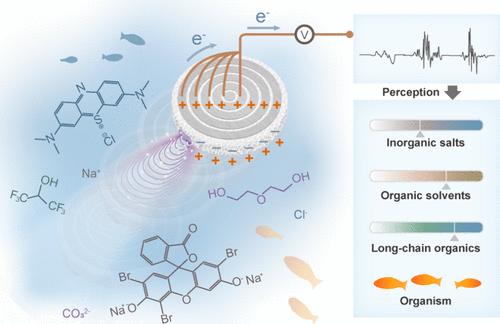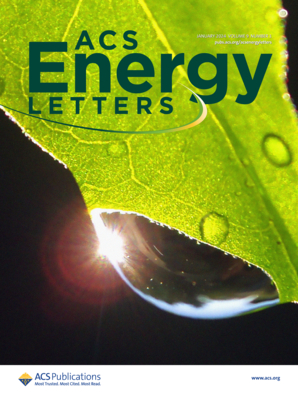Self-Propelled Nanocellulose Aerogel Eco-Robots for Self-Powered Aquatic Environment Perception
IF 19.3
1区 材料科学
Q1 CHEMISTRY, PHYSICAL
引用次数: 0
Abstract
Untethered robots utilizing environmental energy for aquatic information perception are significant for human–robot–environment interactions, which require strategies to reconcile self-powered locomotion and autonomous sensation. Inspired by rove beetles with Marangoni propulsion, we developed a self-propelled nanocellulose aerogel eco-robot with a parallelly patterned electrode array with equal gaps, demonstrating continuous locomotion on water and simultaneous electricity generation via an unreported continuous solid–liquid sliding contact electrification mechanism with sufficient charge transfer. Systematically studying the charge transfer mechanism between the locomotive robot and water surface at different robot geometry, motion status, and diversified water contamination conditions, the self-powered robot achieves locomotion status self-monitoring and water contaminant concentration detection with a high sensitivity of 99.6%. It also demonstrates water–organism interaction including fish motion perception and monitoring. This work proposes a concept for constructing a smart aquatic ecosystem utilizing robots with self-powered mechanical–electrical cooperativity, demonstrating autonomous environmental energy utilization for information acquisition and interaction.

用于感知水生环境的自推进纳米纤维素气凝胶生态机器人
利用环境能量感知水生信息的无系绳机器人对人类-机器人-环境互动具有重要意义,这需要协调自供电运动和自主感知的策略。受具有马兰戈尼推进力的啮齿类甲虫的启发,我们开发了一种自推进纳米纤维素气凝胶生态机器人,该机器人具有等间隙平行图案化电极阵列,通过一种未报道过的具有充分电荷转移的连续固液滑动接触电气化机制,实现了在水上的连续运动和同步发电。通过系统研究不同机器人几何形状、运动状态和不同水污染条件下运动机器人与水面之间的电荷转移机制,自供电机器人实现了运动状态自我监测和水污染物浓度检测,灵敏度高达 99.6%。它还展示了水与生物的互动,包括鱼类的运动感知和监测。这项工作提出了利用具有自供电机电协同功能的机器人构建智能水生生态系统的概念,展示了自主利用环境能源获取信息和进行互动的能力。
本文章由计算机程序翻译,如有差异,请以英文原文为准。
求助全文
约1分钟内获得全文
求助全文
来源期刊

ACS Energy Letters
Energy-Renewable Energy, Sustainability and the Environment
CiteScore
31.20
自引率
5.00%
发文量
469
审稿时长
1 months
期刊介绍:
ACS Energy Letters is a monthly journal that publishes papers reporting new scientific advances in energy research. The journal focuses on topics that are of interest to scientists working in the fundamental and applied sciences. Rapid publication is a central criterion for acceptance, and the journal is known for its quick publication times, with an average of 4-6 weeks from submission to web publication in As Soon As Publishable format.
ACS Energy Letters is ranked as the number one journal in the Web of Science Electrochemistry category. It also ranks within the top 10 journals for Physical Chemistry, Energy & Fuels, and Nanoscience & Nanotechnology.
The journal offers several types of articles, including Letters, Energy Express, Perspectives, Reviews, Editorials, Viewpoints and Energy Focus. Additionally, authors have the option to submit videos that summarize or support the information presented in a Perspective or Review article, which can be highlighted on the journal's website. ACS Energy Letters is abstracted and indexed in Chemical Abstracts Service/SciFinder, EBSCO-summon, PubMed, Web of Science, Scopus and Portico.
 求助内容:
求助内容: 应助结果提醒方式:
应助结果提醒方式:


